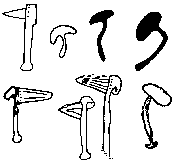Psychotropic Plant Consumption and Early ManWhat inspired the animal to look to the night sky and see, not just stars, but constellations, deities, and mythological stories? What forces drove the evolution of the primate brain to function beyond the boundaries of behavioral instinct and into a universe of perception which displaced time and space, projected meaning and purpose upon environmental elements, and established synthetic symbols and icons for subsequent cultural manipulation? What was it that initially delineated early humans from the physical constrictions of the natural world?
Carl Sagan speculates on such questions in his book, The Dragons of Eden, and offers a little food for thought. He considers a band of human Pygmies that intoxicate themselves on marijuana while performing mundane tasks like fishing or hunting. He casually ponders the possibility that “in human history the cultivation of marijuana led generally to the invention of agriculture, and thereby to civilization” (Sagan, 201). Of course, the “real” world is perhaps a bit more complex than that. The forces that drive human evolution are vast, and modern science continues to unwrap the mysteries of our ontological existence. The fact that every human culture at some point in history practiced the consumption of at least one version of a psycho active substance shouldn’t be ignored when considering the evolution of the human animal (Weil, et al, 10). Some scientists studying the molecular composition of flora have found evidence to suggest a symbiosis between psychoactive plants (i.e. entheogens) and indigenous wild-life consumers(3).
ENTHEOGENS AND ANIMALS:
Psychoactive plants typically manufacture chemicals analogous to neurotransmitters functioning within the mammalian brain(3). Morphine from the opium plant mimics the function of endorphins, and certain cacti like Peyote produce ergot alkaloids and mescaline, which mimic serotonin(3). Tobacco produces nicotine that mimics acetylcholine, coffee beans produce caffeine which mimics adenosine (3), and marijuana produces THC that mimics Anandamide(3). Anthropologist R.J. Sullivan suggests that many of the psycho active plants which mammals consume provide necessary nutrients for brain operation, especially during times of potential malnutrition when food resources become scarce. During these times, mammals that consume psychoactive plants receive many of the chemical compounds necessary for efficient brain function and can survive until other food sources are found(3). Plants that manufacture analogous neurotransmitters potentially take advantage of ecological niches defined by mammalian consumption. Seeds, which can’t be digested, may be transported by an organism and deposited within excrement to a new location, and the boundaries of a plant’s ecological niche are expanded.
To enhance our perspective of the drug-animal relationship, examples of non-human drug consumption should be considered. Chimpanzees have been known to consume “medicinal” plants. In one case, a sick chimpanzee in Tanzania’s Mahale Mountains National Park with “barely enough energy to defecate”(4) dragged herself over to a Vernonia amygdaline bush and plucked a few leaves. She chewed the leaves to extract the juice and spit out the fibrous leftovers. To the surprise of the observing scientists, she was healthy again and socializing with the rest of her troop the next afternoon(4). Chimpanzees on occasion ambulate for twenty minutes to find Aspilia leaves that they ingest to kill parasitic infection(4). Other stories depicting the animal consumption of psychoactive plants include pack donkeys chewing on tobacco, goats munching on qat (an amphetamine like stimulant), and African elephants feasting on fermented fruit (4). In 1979, Ronald Siegel, psychopharmacologist at the UCLA School of Medicine, discovered a shard from a ceramic bowl in the Peruvian Andes depicting an image of two llamas eating from a branch of coca leaves(4). This image and other stories from tribal lore reflect the notion that animals do consume psychotropic plants, and this sets the stage for the emergence of early man possessing a brain refined by mind-bending plant consumption.
ENTHEOGENS AND HUMAN HISTORY:
Drugs are older than history. People all over the world today consume psychotropic substances, and this behavior follows an ancient line of tradition. Using archaeological evidence, we can speculate on the behavioral practices of pre-historic humans, but during the early millennia of human civilization, the consumption of “medicinal” plants predates the emergence of writing and other facets of social organization. From 10,000 to 2,000 BC ancient texts in Egypt, Sumeria, China, and the New World suggest not only that medicinal herbs were used to treat illness, but the ritualized function of psychotropic plant consumption defined early religious belief as well (Roy, et al, 8). Rock paintings in the Sahara Desert and Algeria dating from 9,000 – 7,000 BC depict scenes of “harvest, adoration, and large masked gods covered with mushrooms” (6) and imply the notion that early humans established mushroom religious cults within the time period of the Paleolithic. Other rock paintings found in Tanzania and Australia date from 40,000 BC and earlier (6). Similar rock paintings depicting images following motifs of the “Round Head Period” (9,000 – 7,000 BC) have been discovered in Tadrart Acacus in Libya, Ennedi in Chad, and also at Jebel Uweinat in Egypt (6). A painting at Jabbaren depicts five people kneeling in a row worshipping three figures, and one of the figures is shaped like a large mushroom (6). Clearly, the consumption of psychotropic mushrooms refined the religious beliefs of early humans. Would this behavior influence the evolution of human culture?
Psychotropic mushrooms are commonly found in the dung of cows, horses, and deer (6). This is significant because dung is commonly used by human hunters to track prey (6). The skills required by human hunters to kill game which are often bigger and faster are honed through the exercise of cultural techniques involving displacement in thought, group strategy, and the efficient construction and use of weaponry. The hunter human must “see” beyond natural instinct in order to survive and provide food and shelter for the human family. In this way, cultures which maintain “super natural” systems to govern subsistence and behavior plasticity will out-compete other organisms for survival, especially in an environment of perpetual change. The evolution of culture in human populations would yield the foundations for human civilization and eventually establish Homo sapiens as the ruler of the animal kingdom.
Psychotropic plants of all varieties are found alongside every human civilization. African populations not only consumed mushrooms, but also Qat (Weil, 54), Yohimbe (Weil, 54), and Ibogaine (Weil, 101) to name a few. Mesopotamian, Asian Indian, and Chinese cultures consumed qat (Weil, 54), betel (Weil, 54), opium (Weil, 82), cannabis (Weil, 114) and psychoactive mushrooms were used in Southeast Asian cultures (Weil, 99). The Greeks and Romans consumed opiates (Weil, 82), and Aristotle, Plato, and Sophocles among many others all participated in rituals involving the ingestion of psychotropic fungi during religious ceremonies at the temple of Demeter in Eleusis (6).
New World cultures maintained a profound relationship with entheogenic plants to a greater degree than other world communities because psychoactive flora grew in abundance. (
note- an interesting spin on this subject consists of the idea that perhaps the reason why "old world" entheogens are fewer in number than "new world" entheogens is because humanity's oldest ancestors came from Africa and then spread to other parts of the hemisphere. In this way, our "ancestors" might have had hundreds of thousands, if not millions of years to deplete the Old World populations of native entheogens. Humanity's ancestors are relatively new to the ecological framework of the New World, and therefore perhaps New World entheogens are more numerous because humans have had less time to consume these reasources. ). These plants were: multiple varieties of mushroom (6), peyote and multiple varieties of cacti, convolvulaceae, leguminosae “Red Bean”, Yopo “DMT snuff”, ayahuasca (a culturally varied stew with an MAO inhibitor to catalyze the breakdown of DMT containing vines), coca leaves (Weil, 23), morning glory, (7), and tobacco (3) to name a few. The use of psychoactive plants for recreational, medicinal, and religious purposes is a cultural function shared by humans all over the world. Certainly, such a widespread behavior influenced in some way the evolution of the human mind.
ENTHEOGENS, MIND, AND CULTURE:
Terence McKenna, author of The Invisible Landscape and Food of the Gods, says this in an interview with Alexander Blair-Ewart: “It's a great puzzle for evolutionary biology how it is that in a two million year period the human brain effectively doubled in size. There are evolutionary biologists, Lumsden being one example, who call this the most rapid transformation of a major animal organ in the entire fossil record, and it happened to us.” (8)
It is my belief that the consumption of psychoactive plants contributed to changes in the behavior of early man that influenced this rapid brain development. McKenna suggests that the ritualistic use of psychoactive mushrooms in early human populaces induced radical changes in social behaviors, such as increased visual acuity, stimulated nervous function, increased energy, heightened sexual arousal, and gave rise to religious iconography such as cattle-like “horned goddesses” and other anthropomorphic deities (9). What is significant about this theory is that evolutionary behaviors such as reproductive success and diet can now rapidly adapt, as cultural belief revolutionizes human behavior. A great example of this type of “ontological” transition is found in The Autobiography of a Winnebago Indian by ethnologist Paul Radin. This narrative follows the life of a Winnebago male who enters into the practice of a Peyote cult. Prior to this experience, he lived a life of ambiguous meaning. At a young age, he came to realize that many of his people’s religious rituals were deceptive “shows” to propagate cultural tradition and maintain social order (Radin, 20). He falls away from his tradition and becomes an alcoholic and even lands himself in jail. Finally, some family members convince him join their Peyote cult where he ritualistically consumes peyote and sees “supernatural” visions. Upon experiencing the psychotropic effects of the peyote, he embraces his radical new religious faith, and abandons the polytheistic rituals of his older tradition for the monotheism and enlightenment of the Peyote cult (Radin, 63). In this example, we see the power that the psychedelic experience has on transforming the perceptions AND the behaviors of the psychotropic plant consumer.
In our modern world, human culture influences our evolution in ways unparalleled in the animal kingdom. Humans have invented the symbols of language and math, mythologies, religion, calendars, agriculture, animal domestication, art, science, tools, weapons, material wealth, economies, and all of these creations of the human mind require psychological mechanisms which displace time and space to enhance social function. Although the influence of psychoactive plant consumption on the development of human culture is largely speculative, this idea must be included when constructing any paradigm outlining the evolution of human civilization. Drugs are, after all, older than history.
Bibliography
1) Sagan, Carl. The Dragons of Eden. Ballantine Books. Copyright 1977
2) Weil, Andrew, M.D., et al. From Chocolate to Morphine: Everything You Need to Know About Mind-Altering Drugs. Houghton Mifflin Company. Copyright 1993.
3) Sullivan, R.J., Phd. Psychotropic substance-seeking: evolutionary pathology or adaptation?. http://homepages.ihug.co.nz/~roger_s/ADD024.pdf
4) The Sacramental Use of Cannabis Sativa. http://www.kamakala.com/cannabis.htm
5) Porter, Roy, et al. Medicine: A History of Healing- Ancient Traditions to Modern Practices. Barnes and Noble Books. Copyright 1997.
6) Mushrooms: A History of Magic Mushrooms. http://www.a1b2c3.com/drugs/mus01.htm
7) Schultes, Richard Evans, Ph. D., F.M.L.S. Antiquity of the Use of New World Hallucinogens http://www.heffter.org/review/chapter1.pdf
8) Magical Plants and the Logos: Terence McKenna in a conversation with Alexander Blair-Ewart
http://www.spiritualrealist.com/MINDFIRE/TERENCEM.asp
9) Terence McKenna. “Stoned Ape Theory”. http://users.lycaeum.org/~sputnik/McKenna/Evolution/theory.html
10) Radin, Paul. The Autobiography of a Winnebago Indian- Life, Ways, Acculturation, and the Peyote Cult. Dover Publications, INC. Copyright 1963.
 the world is what we make it
the world is what we make it
























